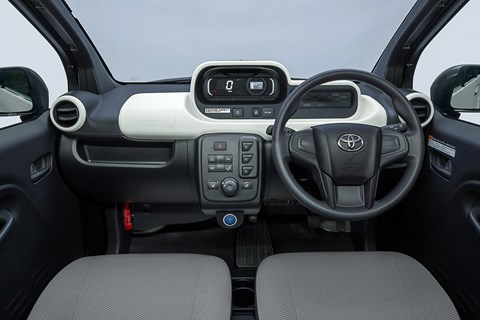► Toyota C+ EV to roll out in Japan
► A tiny 2.5m long electric city car
► 9kWh battery, 93-mile range
Electric cars and Toyota seem to have an uneasy relationship at the moment – at least if Akio Toyoda’s recent pointed dig at the category is anything to go by. In what seems, then, to be little more than awkward timing, Toyota has pushed out its first in-house electric car to the public… and the C+Pod appears to be – on the surface at least – little more than a glorified two-seat city runabout that could have graced a motor show stand as a concept a decade ago.
Previewed ahead of the Covid-stalled 2020 Tokyo Olympic Games as athlete transport, Toyota has stuck to its plan to roll out the diminutive BEV as a (very) small pilot program to government and corporate customers in 2021, before a full roll-out in 2022.
Our guide to the best electric cars
Toyota C+ specs and battery range
At less than 2.5m long, and powered by a tiny 9.2kW/56Nm electric motor, the plastic-panelled C+Pod’s equally small 51Ah/9kWh battery gives it a claimed 150km range, albeit at a top speed of 60km/h.

That, and the fact it carries just two people, limits the C+Pod’s usefulness within city boundaries.
It will take about 16 hours to charge even that small battery, thanks to Japan’s 100-volt domestic power grid. That time reduces to five hours on a 200v system. It can, however, also act as a very large powerbank, offering 1500w, or ten hours, of power via household plugs and USB ports.
While the C+Pod is a Japan-only play at the moment, its launch does come at an interesting time.
Toyota’s rivals are lining up a bevy of BEVs more suited to mass-market consumption that are far closer to sale; indeed, the C+Pod reminds us of early EVs like the decade-old Mitsubishi iMiev, slotting underneath e-superminis such as the Renault Zoe.
Toyota electric cars: the plan

On the flip side, of course, Toyota has almost singlehandedly introduced a swathe of ordinary consumers to the potential benefits of alternative-energy motoring, thanks to its continued dominance of the petrol/electric hybrid space. Such is its advantage, in fact, that it’s one of the only car companies in the world that can weather a longer gestation period as it builds out its EV portfolio.
Living the life electric: CAR magazine’s Honda E long-term test
Toyota’s electric car ambitions
Toyota has long suggested that the road to battery-electric vehicles won’t be taken at high speed, but with governments fast-forwarding plans to ban the sale of fossil fuel-only powered cars, it appears that it may have to put its foot on the throttle a bit harder.
It recently announced that it would unveil a battery-electric SUV, while reports suggest that new battery technology – potentially based on fluoride-ion chemistry – may give the company a jump start over incoming competitors.
However, nothing will hit showrooms until 2025, which will provide a handy lead to its competitors.
Further electric car reading
How much does it cost to charge an electric car?
The best cheap EVs
How to buy a used electric car